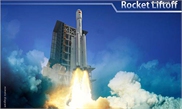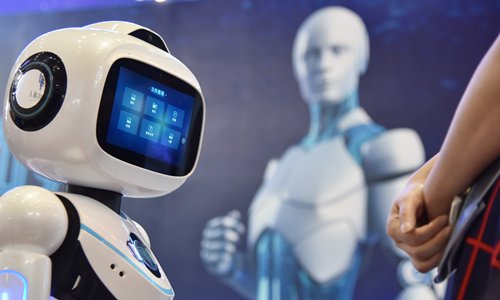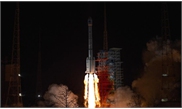https://youtu.be/ESBCkgUvW6A
https://youtu.be/9rtNDywglu4
China's first cargo spacecraft, Tianzhou-1, was launched successfully at 7:41 pm Beijing Time Thursday, a crucial step for the country to build a space station by approximately 2022.
Lifted by a Long March-7 Y2 carrier rocket, Tianzhou-1 roared into space from Wenchang Space Launch Center in Hainan Province on Thursday evening.
The cargo ship will dock with the orbiting Tiangong-2 space lab, provide fuel and other supplies, and conduct space experiments before falling back to Earth. The launch of Tianzhou-1 was a "zero-window" mission, which means it had to be launched at precisely 7:41:28 pm, with no room for error, China Central Television reported.
The cargo ship is 10.6 meters long and has a maximum diameter of 3.35 meters. Its maximum takeoff weight is 13.5 tons, allowing it to carry over 6 tons of supplies. Tianzhou-1 is larger and heavier than Tiangong-2, which is 10.4 meters in length and has a maximum diameter of 3.35 meters, weighing 8.6 tons, the Xinhua News Agency reported.
"Tianzhou-1's cargo usually includes space food, medicine, water and so on, for three people's use for 30 days, but this time it is a unmanned flight, so we put simulated cargo that weighs the same in the spacecraft," Huang Weifen, deputy chief designer of China's manned space project astronaut system, told the Global Times.
The biggest challenge of this mission is that new spacecraft, new rockets and the new launch site need to match each other, Xu said. When Tianzhou-1 completes its mission, it will make an automatic destructive re-entry into Earth's atmosphere.
"This shows that China's environmental awareness of space has improved, and this is a good attempt to reduce space junk. Tianzhou-1 will fall into the South Pacific under our control when its mission ends," Xu said.
Advanced technology
Bai Mingsheng, chief designer of the cargo ship, told Xinhua that the cargo aboard the spacecraft weighs almost the same as the ship, exceeding the load capacity of Russian cargo ships in active service. If the Tianzhou-1 mission is successful, China will become the third country besides Russia and the US to master the technique of refueling in space.
"In general, Tianzhou-1's technology is definitely in the first-class around the globe, at the same stage as Russia and the US. Although Europe and Japan also have their own cargo spacecraft and their payload capacity is bigger than Tianzhou-1, they heavily rely on US and Russian technological support in various aspects," Song Zhongping, a military expert who served in the Second Artillery Corps (now known as the PLA Rocket Force), told the Global Times on Thursday.
From launch to automatic destruction, China's Tianzhou-1 doesn't need to rely on any other country's facilities or technology, and compared to the US' Cygnus and Dragon, its payload capacity is bigger and technologically more reliable and advanced in general, Song said.
Space ambition
China aims to build a permanent space station that is expected to orbit for at least 10 years, and the maiden voyage of the cargo ship is important as it will be a courier to help maintain the space station. Without a cargo transportation system, the station would run out of power and basic necessities, causing it to fall back to Earth before the designated time, Xinhua reported.
Currently, the only space station is the International Space Station (ISS), which was mainly pushed by the US and Russia and was launched in 1998. It should reach the end of its mission in 2020, but the US and Russia might decide to extend its lifetime a little bit, Song said.
According to previous reports in the Global Times, in order to prevent China from sharing in advanced space technology, the US always refused any attempt from China to join the ISS program, despite efforts China made in 2000.
"But we are going to have our own space station very soon. After 2020, China's Tiangong will very likely become the only space station in service, and will provide services to more developing countries so more countries can benefit from humanity's achievements in space technology," Song said.
Source: By Liu Yang in Wenchang and Yang Sheng in Beijing Source:Global Times Published: 2017/4/21 0:08:39
First cargo spacecraft boosts China's space dream
https://youtu.be/wjNT1p6Ayu8
WENCHANG, Hainan, April 20 (Xinhua) -- China has taken another step toward its goal of putting a space station into orbit around 2022, by sending its first cargo spacecraft Tianzhou-1 into space on Thursday evening.
Atop a Long March-7 Y2 carrier rocket, Tianzhou-1 rose into the air from the Wenchang Space Launch Center in south China's Hainan Province at 7:41 p.m.
China declared the launch a success after it entered designated orbit minutes later.
The cargo ship will dock with the orbiting Tiangong-2 space lab where two Chinese astronauts spent 30 days in the country's longest-ever manned space mission, provide fuel and other supplies to the latter, as well as conduct space experiments before falling back to Earth.
If the Tianzhou-1 mission is successful, China will become the third country besides Russia and the United States to master the technique of refueling in space.
China aims to build a permanent space station that is expected to orbit for at least 10 years, and the debut of the cargo ship is important as it acts as a courier to help maintain the space station.
Without a cargo transportation system, the station would run out of power and basic necessities, causing it to return to Earth before the designated time.
"The Tianzhou-1 mission includes the breakthrough of in-orbit refueling and other key technology needed to build a space station, laying a foundation for future space station operations," said Bai Mingsheng, chief designer of the cargo ship.
THREE DOCKINGS
Measuring 10.6 meters long and boasting a maximum diameter of 3.35 meters, the Tianzhou-1 cargo ship has a maximum takeoff weight of 13.5 tonnes, and could carry over 6 tonnes of supplies.
Tianzhou-1 is larger and heavier than Tiangong-2, which is 10.4 meters in length and has a maximum diameter of 3.35 meters, weighing 8.6 tonnes.
Bai said that supplies loaded on the cargo spacecraft are nearly as heavy as the ship's own weight, exceeding the loading capacity of Russian cargo ships in active service.
Tianzhou-1 will dock with Tiangong-2 three times, said Bai. After the first docking, aerospace engineers will test the controlling ability of the cargo spacecraft over the two spacecraft.
The second docking will be conducted from a different direction, which aims to test the ability of the cargo ship to dock with the space station from different directions.
In the last docking, Tianzhou-1 will use fast-docking technology. Previously, it took China about two days to dock, while fast docking will take about six hours, according to Bai.
Refueling is conducted during docking, a process that is much more complicated than refueling vehicles on land.
The refueling procedure will take 29 steps and last for several days each time.
This means the Tianzhou-1 will stay in space for about six months. It will fall into a designated sea area after fulfilling its tasks.
SUPPORTING SPACE STATION
Space cargo ships play a crucial role in the maintenance of a space station.
Cargo ships can send all kinds of supplies to the space station which can be an experiment field for developing technology in space.
Huang Weifen, a deputy chief designer of the Astronaut Center of China, said that supplies carried by Tianzhou-1 include goods that will meet the basic living and working needs of three astronauts for 30 days in space, including drinking water, oxygen bottles and nitrogen bottles.
Also onboard include facilities for microorganism tests, and sensors are installed to obtain data such as mechanics and temperature for the future design of the space suit outside a spacecraft.
"We hope to gather relevant data through this mission and accumulate experience for sending material for the future space station," she said.
VISION OF SPACE POWER
Although China has achieved many giant steps in space exploration, the country's space odyssey is far from over as it eyes building its own space station and far beyond that: landing on Mars.
In 1992, the central authority approved a three-step manned space program.
The first step, to send an astronaut into space and return safely, was fulfilled by Yang Liwei in Shenzhou-5 mission in 2013.
The second step was developing advanced space flight techniques and technologies including extra-vehicular activity and orbital docking.
The final step will be able to operate a permanent manned space station.
Chinese scientists said they plan to launch a core module of the country's first space station around 2018, followed by two experiment modules.
The station in the primary stage will be composed of three modules: core module, experiment module I and experiment module II. Each module will weigh more than 20 tonnes and together the three will be structured in the shape of T. The core module will be in the middle with an experiment module on each side.
During its operation, the space station could be linked to one additional cargo ship and two manned spacecraft at one time, and the maximum weight of the whole assembly could reach up to 90 tonnes.
Based on such design, scientists will keep updating capsules in accordance with scientific research and extend their abilities.
With the International Space Station set to retire in 2024, the Chinese space station will offer a promising alternative, and China will be the only country with a permanent space station.
So far, China has successfully launched 11 Shenzhou series spacecraft, including six manned spacecraft that lifted 11 astronauts into space.
The country strives to realize the third step of its lunar program in 2017: sending Chang'e-5 lunar probe onto the moon which will return with samples.
Source: Xinhua| 2017-04-20 21:17:45|Editor: Mu Xuequan
Related articles:
Graphics shows launch procedure of China's first cargo spacecraft Tianzhou-1
Graphics shows the launch procedure of China's first cargo spacecraft Tianzhou-1 on April 20, 2017. (Xinhua/Ma Yan)Viral video of robot workers highlights massive role AI will take in future
A video featuring hundreds of orange robots sorting packages, scuttling across a factory platform like an army of ants, went viral in China over the past week.
Related posts:













